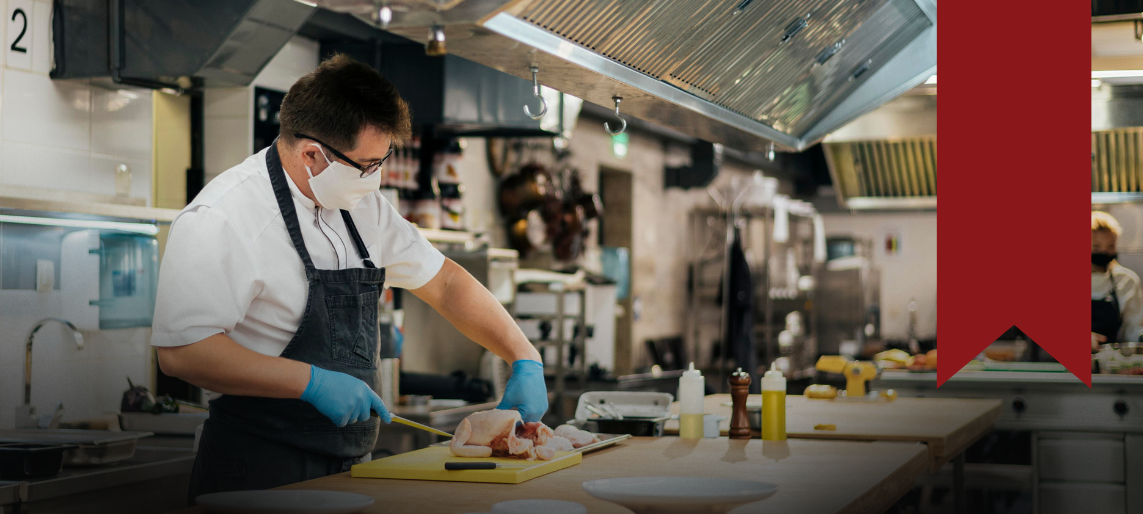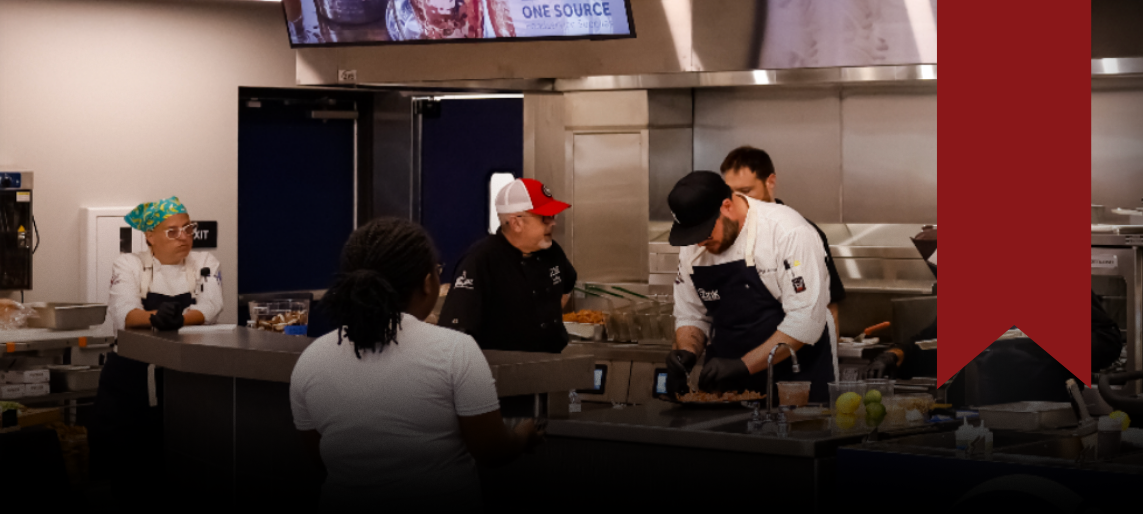
Summary
Summary
With COVID-19 cases climbing again, commercial kitchens must protect staff and customers while keeping operations running. Explore cleaning protocols, ventilation upgrades, PPE policies, and foodservice-specific best practices to reduce risk.
COVID-19 cases are on the rise again, and commercial kitchens—whether in hospitals, schools, restaurants, or government facilities—remain high-touch, high-traffic environments where safety is essential. For operators, the focus is twofold: protect people while ensuring business continuity.
Maintaining rigorous health and safety protocols in the foodservice environment not only prevents illness but also helps avoid costly shutdowns, staffing shortages, and reputational damage. Here’s a comprehensive guide to keeping your kitchen safe and operational during this latest COVID-19 wave.
1. Strengthen Cleaning and Sanitation Protocols
Why it matters: COVID-19 can be transmitted via airborne particles and, in some cases, contaminated surfaces. In fast-paced kitchens, high-touch areas can become contamination points if not disinfected often.
Best Practices:
- Increase cleaning frequency for handles, prep tables, door latches, light switches, POS systems, and shared utensils.
- Use EPA List N–approved disinfectants with proven efficacy against SARS-CoV-2.
- Adopt a color-coded cleaning tool system to separate supplies used for raw food prep, cooking areas, and service areas.
- Keep a sanitation log to track and verify that cleanings are done on schedule.
- Ensure dishwashing equipment meets sanitization standards—ideally using high-temperature sanitizing cycles or appropriate chemical sanitizers.
2. Improve Ventilation and Air Quality
Why it matters: The CDC emphasizes that good ventilation reduces the concentration of airborne viral particles, lowering the risk of transmission in enclosed spaces.
Best Practices:
- Keep kitchen hoods, vents, and exhaust systems cleaned and in proper working order.
- Consider HEPA filtration units in areas where air exchange is limited, such as break rooms or prep rooms without windows.
- Increase the rate of air exchanges where possible, either through existing HVAC adjustments or portable ventilation solutions.
- Use CO₂ monitors to identify areas with poor air circulation and adjust airflow accordingly.
3. Reinforce Personal Hygiene and PPE Use
Why it matters: In busy kitchens, staff are often working in close proximity. PPE and good hygiene can drastically reduce the likelihood of virus transmission.
Best Practices:
- Require frequent handwashing with warm water and soap for at least 20 seconds—especially before food prep, after touching high-touch surfaces, and after coughing or sneezing.
- Provide hand sanitizer stations at every work zone.
- Supply disposable masks, face shields, or respirators during periods of elevated risk, particularly in confined prep spaces.
- Regularly train staff on proper mask usage—covering both nose and mouth, avoiding frequent touching, and changing when damp.
4. Maintain Staff Wellness and Screening
Why it matters: COVID-19 can spread quickly if even one symptomatic employee comes to work. A proactive wellness policy minimizes that risk.
Best Practices:
- Implement daily symptom checks or wellness questionnaires.
- Encourage employees to stay home if they are sick—and consider flexible sick leave to remove the fear of lost income.
- Schedule staggered start times and breaks to reduce crowding in common areas.
- Offer COVID-19 testing resources and communicate how employees can access them.
5. Leverage Equipment to Support Safety
Why it matters: Kitchen equipment isn’t just about cooking—it can be a frontline defense against the spread of viruses. By selecting the right commercial kitchen equipment and optimizing how it’s used, operators can reduce high-touch points, improve sanitization, and enhance overall safety.
Best Practices:
- Hands-Free Fixtures and Controls
Motion-activated faucets and soap dispensers from T&S Brass or Advance Tabco make handwashing more sanitary by eliminating handle contact. Paper towel dispensers from San Jamar or Bobrick and foot-pedal–operated sinks are excellent in prep areas. Hands-free trash receptacles from Rubbermaid Commercial Products further reduce shared surface contact.
- High-Temperature Dishwashers & Warewashers
Use dishwashers capable of reaching NSF-recommended sanitizing temperatures (180°F+ final rinse). Conveyor and flight-type models from Champion handle high volumes and meet rigorous sanitization standards for busy kitchens.
- Touchless Beverage & Ice Dispensing
Ice machines with automatic dispensing from Follett or Scotsman prevent multiple hands from touching scoops, levers, or bins. Beverage dispensers from Bunn or Lancer with touchless controls help reduce contamination in self-service areas.
- Temperature Monitoring & Alerts
Refrigeration systems from True Manufacturing or Turbo Air with built-in digital controls and remote monitoring provide alerts if temperatures drift outside safe ranges. This ensures food safety even during staffing shortages and supports HACCP compliance.
- Anti-Microbial Surfaces & Coatings
Stainless steel tables from Advance Tabco and cutting boards from San Jamar with antimicrobial additives slow bacterial growth between cleanings, especially in high-contact zones.
- Dedicated Equipment for Staff Areas
Separate microwaves, refrigerators, and utensils for staff use—such as compact units from Panasonic or Amana—can help prevent cross-contact with customer-facing equipment.
- Automated Cooking & Portioning Systems
Fryers from Frymaster or Pitco with automatic basket lifts reduce the number of touches needed during cooking. Programmable ovens from Rational, Alto-Shaam, or Blodgett ensure consistency while minimizing manual handling.
- Upgraded Ventilation Equipment
Kitchen ventilation systems from CaptiveAire or Accurex with integrated filtration can capture fine particles and improve air quality in both prep and service areas—important for reducing airborne contaminants.
6. Keep Communication Clear and Consistent
Why it matters: Staff compliance depends on understanding expectations. Customers also feel safer when they know safety measures are being taken seriously.
Best Practices:
- Post updated COVID-19 safety policies in visible staff areas and entry points.
- Hold brief safety huddles at the start of each shift to review protocols.
- Train new hires immediately on hygiene, cleaning, and PPE requirements.
- Maintain a clear line of communication with local health departments and follow evolving guidance.
7. Prepare a Rapid Response Plan
Why it matters: Even with precautions, exposure can happen. Being ready to respond limits operational disruption.
Best Practices:
- Identify a point person for COVID-19 safety and incident response.
- Have a plan for immediate cleaning and sanitization if an employee tests positive.
- Establish a staffing backup plan to cover shifts if multiple team members are quarantined.
- Keep a contact tracing log to assist health officials if necessary.
Final Thoughts
Preventing COVID-19 in a commercial kitchen is about more than meeting health code requirements—it’s about safeguarding your team, protecting your customers, and ensuring your business stays open. The combination of enhanced cleaning, improved air quality, consistent PPE use, proactive wellness checks, and smart equipment choices creates a layered defense that reduces risk.
By treating safety as a core operational value, foodservice operators can navigate this latest wave of COVID-19 while maintaining trust, morale, and efficiency.
Frequently Asked Questions
1. How can commercial kitchens maintain safe operations during a COVID-19 surge?
The key is a layered approach: combine frequent cleaning, improved ventilation, and strict PPE compliance. We recommend following CDC and FDA guidance while integrating high-efficiency kitchen equipment, such as touchless dispensers, high-temperature dishwashers, and automated cooking systems, to minimize manual contact and keep foodservice lines moving safely.
2. What equipment upgrades make the biggest impact on health and safety?
Touchless and antimicrobial solutions make a measurable difference. Hands-free faucets, motion-activated dispensers, high-temperature warewashers, and antimicrobial prep tables all help reduce cross-contamination. We partner with trusted manufacturers like T&S Brass, Champion, Rational, and CaptiveAire to deliver equipment that meets both safety and performance standards in healthcare, military, and commercial kitchens.
3. How does Aldevra support government and commercial kitchens with COVID-19 prevention?
We provide compliant, turnkey equipment solutions through GSA MAS and OASIS+ contracts helping agencies upgrade sanitation and ventilation systems quickly. We understand the urgency of mission support and ensures installations meet federal safety and health requirements.
4. What are best practices for staff safety and communication in high-volume kitchens?
Transparent communication and clear accountability are essential. Managers should post updated safety procedures, conduct daily wellness checks, and assign a COVID-19 safety lead.
5. How can kitchens prepare for potential COVID-19 exposures without shutting down?
Having a rapid response plan in place prevents panic and downtime. Designate a point of contact, outline isolation and cleaning procedures, and maintain contact tracing logs.











